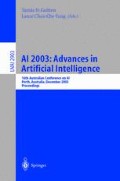Abstract
In this paper, a method for pitch independent musical instrument recognition using artificial neural networks is presented. Spectral features including FFT coefficients, harmonic envelopes and cepstral coefficients are used to represent the musical instrument sounds for classification. The effectiveness of these features are compared by testing the performance of ANNs trained with each feature. Multi-layer perceptrons are also compared with Time-delay neural networks. The testing and training sets both consist of fifteen note samples per musical instrument within the chromatic scale from C3 to C6. Both sets consist of nine instruments from the string, brass and woodwind families. Best results were achieved with cepstrum coefficients with a classification accuracy of 88 percent using a time-delay neural network, which is on par with recent results using several different features.
Access this chapter
Tax calculation will be finalised at checkout
Purchases are for personal use only
Preview
Unable to display preview. Download preview PDF.
References
Wold, E., Blum, T., Keislar, D., Wheaton, J.: Classification, search and Rereval of audio. IEEE Multimedia Magazine 3(3), 27–36 (1996)
Herrera, P., Amatraiain, X., Batlle, E., Serra, X.: Towards instrument segmentation for music content description: A critical review of instrument classification techniques. In: Proceedings of the International Symposium On Music Information Retreival (2000)
Kostek, B., Krolikowski, R.: Application of artificial neural networks to the recognition of musical sounds. Archives of Acoustics 22(1), 27–50 (1997)
Cemgil, A., Gurgen, F.: Classification of musical instrument sounds using neural networks. In: Proceedings of SUI 1997 (1997)
Brown, J.: Computer identification of musical instruments using pattern recognition with cepstral coefficients as features. J. Acoust. Soc. Am. 105, 1933–1941 (1999)
Eronen, A., Klapuri, A.: Musical instrument recognition using cepstral coefficients and temporal features. In: Proceedings of the IEEE International Conference an Acoustics, Speech and Signal Processing (2000)
Helmholtz, H.: On the sensations of tone as a physiological basis for the theory of music. Dover, A. J. Ellis Trans. (1954)
Martin, K., Kim, Y.: Musical instrument identification: A pattern-recognition approach. In: 136th Meeting of the Acoustical Society of America (October 1998)
Bregman, S.: Auditory scene analysis: The perceptual organisation of sound. MIT Press, Cambridge (1990)
Abdallah, S., Plumbley, M.: Unsupervised learning in neural networks for auditory perception and music cognition. Cambridge Music Processing Colloquium (September 1999)
Fritts, L.: Musical instrument samples web page, tech. rep., University of Iowa (2002) http://theremin.music.niowa.edu/web/sound/
Randall, R.: Frequency Analysis. Bruel and Kjaer, Naerum (1987)
Waibel, A., Hanazawa, T., Hinton, G., Schikano, K., Lang, K.: Phoneme recognition using time-delay neural networks. IEEE Transactions in Acoustics, Speech and Signal Processing 37 (1989)
Dayhoff, J.: Neural Network Architectures - An Introduction. Van Nostrand Reinhold, New York (1990)
Waibel, A.: Consonant recognition by modular construction of large pnonetic timedelay neural networks. Neural Information Processing Systems, 215–223
Grey, J.: Multidimensional perceptual scaling of musical timbres. J. Acoust. Soc. Am. 61(5), 1270–1271 (1977)
Kaminskyj, I.: Multi-feature musical instrument sound classifier w/user determined generalisation performance. In: Proceedings of ACMA 2002 (2002)
Author information
Authors and Affiliations
Editor information
Editors and Affiliations
Rights and permissions
Copyright information
© 2003 Springer-Verlag Berlin Heidelberg
About this paper
Cite this paper
Piccoli, D., Abernethy, M., Rai, S., Khan, S. (2003). Applications of Soft Computing for Musical Instrument Classification. In: Gedeon, T.(.D., Fung, L.C.C. (eds) AI 2003: Advances in Artificial Intelligence. AI 2003. Lecture Notes in Computer Science(), vol 2903. Springer, Berlin, Heidelberg. https://doi.org/10.1007/978-3-540-24581-0_75
Download citation
DOI: https://doi.org/10.1007/978-3-540-24581-0_75
Publisher Name: Springer, Berlin, Heidelberg
Print ISBN: 978-3-540-20646-0
Online ISBN: 978-3-540-24581-0
eBook Packages: Springer Book Archive

